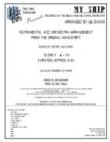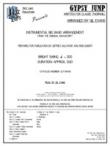LA PALOMA [DOWNLOAD]
Recorded by the Claude Thornhill Orchestra
Arranged by Gil Evans, Edited by Rob DuBoff and Jeffrey Sultanof

Cat #: JLP-8137-DL
$75.00This product is available for immediate download after purchase.
Questions?
Please call +1-518-587-1102 or email us.
Edition: Jazz Big Band Arrangement
Description: Straight Eighth - Advanced
Publisher: Jazz Lines Publications
The Claude Thornhill Orchestra was moderately successful before WWII, and after the war, Thornhill re-formed the orchestra with Gil Evans as chief arranger and now musical director. The original instrumentation of the band in 1946 was 4 trumpets, 3 trombones, 5 reeds and rhythm section. By the time La Paloma was arranged in June of 1947, the brass section now consisted of 3 trumpets, 2 trombones, tuba, 5 reeds and rhythm. The source for this publication is Evans's original score. It must have been arranged during the transition period when the band lost a trumpet and trombone, as most of the score includes parts for these instruments, as well as a sixth reed. Unfortunately, in re-scoring parts of the arrangement for this reduced brass section, Evans threw out 2 pages of score and re-scored these bars; the additional trumpet, trombone and reed are not here. For that reason, it is now difficult to restore these parts, and we have not attempted to do this. Even though the discographical listing for the Columbia recording of June 30, 1947 lists Bill Barber present playing tuba, there is no tuba part on this score, and tuba is not heard on the recording. Once again, Evans presents us with music that has various challenges, which only increases respect for the musicianship of the Thornhill Orchestra. Anyone who heard the recording and questioned whether it was too slow because it sounded in the key of E Major can now be assured that E Major is in fact the key of the first part of the arrangement (the introduction on the manuscript has no key signature). For the second chorus, Evans modulates to G Major via a G chord over a Ab pedal!
It is obvious that intonation is a key factor in playing this music properly, but just as important are the horn lines which often serve as accompaniment to the piano. Horns need to listen carefully so that the parts synchronize properly. As with most of the Thornhill book, dynamics must be carefully observed. The reeds are arranged for 4 clarinets (reed 5 doubles baritone sax.) and 1 bass clarinet. We have included optional alternate parts for the two horns (trumpet 4 and trombone 3). But, to achieve the proper sound and balance we strongly recommend using the horn parts if at all possible and not using the alternate brass parts. This is a great opportunity to feature your piano player.
Ranges:
- Trumpet 1: to C#6
- Trombone 1: B4
Reed 1: Clarinet
Reed 2: Clarinet
Reed 3: Clarinet
Reed 4: Bass Clarinet
Reed 5: Clarinet/Baritone Saxophone
3 Trumpets
2 Horns in F
2 Trombones
Guitar
Piano
Bass
Drums
Trumpet 4: Alt Part for Horn 1
Trombone 3: Alt Part for Horn 2







